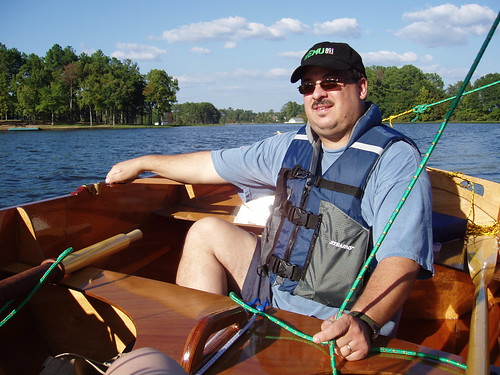Over the past couple of days, I have been adding coats of epoxy to the hull exterior  to fill the weave of the glass cloth. Between the last two, I sanded the surface with 100-grit paper to knock the peaks off the texture that was printing through the epoxy. With a nice, smooth surface produced, I then flipped the hull. The next step was to install some fittings, including seat cleats and brackets for the foot brace rails. The forward set of brackets are normally through-bolted, with a bolt head visible on the hull exterior. Instead, I used some special fittings with a bolt and perforated plate which were glassed onto the hull interior. The position for the forward foot brace rails was measured and marked. The substitute bolts require the plastic rails be drilled out slightly to enlarge the existing mounting holes. These bolt brackets were then glassed on the surface of the hull with a combination of silica thickened epoxy and unthickened epoxy to wet the glass tape that had been cut in 3" x 3" squares with a hole cut in the center. Once the glass was wetted, I taped the bolt to hold it in place. The instructions call for rolling the hull on its side and allowing gravity to hold the mount in place until the epoxy cures. This would have been easier and neater.
to fill the weave of the glass cloth. Between the last two, I sanded the surface with 100-grit paper to knock the peaks off the texture that was printing through the epoxy. With a nice, smooth surface produced, I then flipped the hull. The next step was to install some fittings, including seat cleats and brackets for the foot brace rails. The forward set of brackets are normally through-bolted, with a bolt head visible on the hull exterior. Instead, I used some special fittings with a bolt and perforated plate which were glassed onto the hull interior. The position for the forward foot brace rails was measured and marked. The substitute bolts require the plastic rails be drilled out slightly to enlarge the existing mounting holes. These bolt brackets were then glassed on the surface of the hull with a combination of silica thickened epoxy and unthickened epoxy to wet the glass tape that had been cut in 3" x 3" squares with a hole cut in the center. Once the glass was wetted, I taped the bolt to hold it in place. The instructions call for rolling the hull on its side and allowing gravity to hold the mount in place until the epoxy cures. This would have been easier and neater.

The aft pair of foot braces will be screwed into riser blocks so as to clear the hanging knee in that location. These blocks were simply epoxied into position and held in place with tape while the epoxy cured.
Finally, simple 3/4" x 3/4" pieces of lumber were epoxied into place on the hull floor to serve as seat cleats, or guide rails for the seat assemblies. Care must be taken to use the correct pieces of wood: for each seat there are four pieces of lumber- three are longer than the fourth. Two of the long pieces are used as the seat guides, while the third is used as a structural part of the lower seat. The fourth, shorter piece is used as a structural part of the seat back. The guides were measured and aligned, then epoxied into place with silica thickened epoxy and weighted until cured. Total hours 28.25.

 The aft pair of foot braces will be screwed into riser blocks so as to clear the hanging knee in that location. These blocks were simply epoxied into position and held in place with tape while the epoxy cured.
The aft pair of foot braces will be screwed into riser blocks so as to clear the hanging knee in that location. These blocks were simply epoxied into position and held in place with tape while the epoxy cured.
1 comment:
Very good write up. Thanks.
I liked the idea of mounting the footbraces from the inside without piercing the hull. The bolts with the perforated plate were inexpensive and quite appealing. The instruction to turn the hull on its side while gluing the plate in place seems difficult to execute. Instead I mounted the bolts to the footrails, then used 5-minute epoxy to hold everything in place.
After 5 minutes the bolts are glued in the proper position and I could removed the footrail. I then proceeded to wet the 3x3 glass patch and epoxy this reinforcement in place. It should now be positioned correctly and be strong enough to push against.
Post a Comment